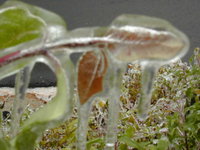Winter storm
|
|
A winter storm is a storm in which the dominant varieties of precipitation are forms that only occur at cold temperatures, such as snow or sleet, or a rainstorm where ground temperatures are cold enough to allow ice to form. These storms are not restricted to the winter season, but may occur in the late autumn and early spring. The most powerful winter storms usually occur in March and, in regions where temperatures are cold enough, April.
| Contents |
Snowstorms
Snowstorms are storms where large amounts of snow fall. Snow is less dense than liquid water, sometimes by a factor of 10. Therefore, an amount of water that would produce 2 cm (0.8 in.) of rain could produce as much as 20 cm (8 in.) of snow. Five centimeters of snow (2 in.) is enough to create serious disruptions to traffic and school transport (because of the difficulty of maneuvering school buses on slick roads). This is particularly true in places not habituated to heavy snowfalls (e.g., Atlanta, Seattle, London). In places where snowfall is common, such as Buffalo, New York, and Minneapolis, such small snowfalls are rarely disruptive, though snowfalls in excess of 15 cm (6 in.) usually are.
A massive snowstorm with heavy winds is known as a blizzard. A large number of heavy snowstorms, some of which were blizzards, occurred in the United States during the early and mid-1990s, and the 1993 "Superstorm" was manifest as a blizzard in most of the affected area.
Large snowstorms can be quite dangerous: a 15 cm (6 in.) snowstorm will make some unplowed roads impassible, and it is possible for automobiles to get stuck in the snow. Snowstorms exceeding 30 cm (12 in.) will cave roofs of some homes and cause the loss of power. Standing dead trees can also be brought down by the weight of the snow.
Secondary dangers
Snowstorms are usually considered less dangerous than ice or sleet storms. However, there are secondary dangers of the ambient snow that may result from a snowstorm. Mountain snowstorms can produce cornices and avalanches. An additional danger, following a snowy winter, is spring flooding if the snow melts suddenly due to a dramatic rise in air temperature.
"Wintry mix"
Many factors influence the form precipitation will take, and atmospheric temperatures are influential as well as ground conditions. Sometimes, near the rain/snow interface a region of sleet or freezing rain will occur. It is difficult to predict what form this precipitation will take, and it may alternate between rain and snow. Therefore, weather forecasters just predict a "wintry mix". Usually, this type of precipitation occurs at temperatures between -2°C and 2°C (28°F–36°F).
Freezing rain and ice storms
IceStormPowerLines.png
Freezing rain storms are one of the most dangerous types of winter storm. They typically occur when a layer of warm air hovers over a region, but the ambient temperature is near 0°C (32°F), and the ground temperature is sub-freezing. A storm in which only roads freeze is a "freezing rain storm"; one resulting in widespread icing of plants and infrastructure is an "ice storm".
While a 10 cm (4 in.) snowstorm is somewhat managable, by the standards of the northern United States and Canada, a comparable 1 cm (0.4 in.) ice storm will paralyze a region: driving becomes extremely hazardous, telephone and power lines are destroyed, and crops may be ruined. Because they do not require extreme cold, ice storms often occur in warm temperature climates (such as the southern United States) as well as cooler ones. Ice storms in Florida will often destroy entire orange crops.
Notable ice storms include an El Niņo-related ice storm, in January 1998, that affected upstate New York and much of eastern Canada, including Montreal. Three million people lost power, some for as long as six weeks. One-third of the trees in Mount Royal park were destroyed, as well as a large proportion of the sugar-producing maple trees. The amount of economic damage caused by the storm has been estimated at Can. $3 billion. See also 1998 Ice Storm
In December 2002, an ice storm in North Carolina resulted in massive power loss throughout much of the state, and property damage due to falling trees. Snow and icy conditions are rare in North Carolina, even in the winter.
Arctic cyclones
The largest snowstorms form around polar low-pressure systems and are known as arctic cyclones. In other cases, similar storms can form around high-pressure systems and create anticyclonic storms.
Categories: Storms | Snow

